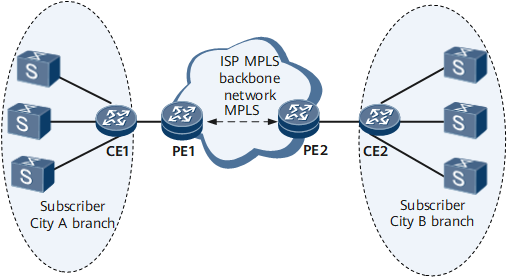Enterprise Leased Line Service Bearer Using PWE3
Service Overview
As globalization gains momentum, more and more enterprises set up branches in foreign countries and requirements for office flexibility are increasing. An urgent demand for carriers is to provide Layer 2 links for enterprises to set up their own enterprise networks, so that enterprise employees can conveniently visit enterprise intranets from outside their offices.
Various types of backbone networks have been constructed by carriers, using different technologies. For example, carriers construct backbone public switched telephone networks (PSTNs) to carry voice services, and PPP (Point-to-Point Protocol) backbone networks to transmit PPP data. With the exponential growth of IP services, carriers have also constructed IP backbone networks. In addition to the backbone networks, diverse access networks are constructed, which are of different types and difficult to achieve interoperability. Therefore, it is a crucial task for carriers to find a method to effectively integrate these networks, enhance network utilization, and provide more types of services to users.
VPWS is a key technology to the MAN. VPWS enables the original access mode to be well integrated with existing IP backbone networks. This implementation reduces repetitious network construction and operational costs. With VPWS, the IP backbone network joins diverse access networks, achieving extension to and enhancement of the conventional data network. After the MPLS backbone network is constructed, the conventional data communications networks, such as PPP networks, can function as access networks. Users, however, are not aware of such changes in the network architecture. In addition, VPWS enables access networks using different protocols to interwork with each other. For example, PPP users can communicate with each other.
Usage Scenario
Figure 1 shows a typical single-segment VPWS application, with the IP network being the backbone network. Different LANs access the backbone network.
A carrier constructs a national backbone network that provides VPWS services to a client with two branches, one in City A, and the other in City B. The branch in City A accesses the backbone network using PPP, whereas the branch in City B accesses the backbone network using PPP. In this situation, the carrier can establish a VPWS connection between the two access points, that is, PE1 in City A and PE2 in City B.
In so doing, the carrier can provide the user point-to-point VPN services that traverse the Wide Area Network (WAN). Besides establishing a VPWS connection, no other special measures have to be taken by the carrier. With the simple and convenient VPWS solution, the user can enjoy point-to-point VPN services without having to modify the original intranet, and the carrier can implement smooth transition to the IP backbone network without having to modify existing access modes.
Feature Deployment
- IP addresses and IGPs are configured on the carrier's MPLS backbone network for communication between PEs.
- MPLS is enabled on the carrier's backbone network. TE tunnels are configured between PE1 and PE2. Usually, two TE tunnels are configured between PE1 and PE2, one as the primary tunnel and the other as the backup tunnel.
- MPLS L2VPN is enabled on PE1 and PE2 and a remote MPLS LDP session is configured between PE1 and PE2.
- PWE3 is configured on the AC interfaces of PE1 and PE2, so that PE1 and PE2 can communicate over MPLS L2VCs.
